Parliament of South Australia
The Parliament of South Australia at Parliament House, Adelaide is the bicameral legislature of the Australian state of South Australia. It consists of the 47-seat House of Assembly (lower house) and the 22-seat Legislative Council (upper house). All of the lower house and half of the upper house is filled at each election. It follows a Westminster system of parliamentary government with the executive branch required to both sit in Parliament and hold the confidence of the House of Assembly.
The Queen is represented in the State by the Governor of South Australia. According to the South Australian Constitution, unlike the Federal Parliament, and the parliaments of the other states of Australia, neither the Sovereign or the Governor is considered to be a part of the South Australian Parliament. However, the same role and powers are granted to them.[1]
History

The Legislative Council was the first Parliament in South Australia, formed as a result of the South Australia Act 1842, and replaced the South Australian Colonisation Commission appointed in 1834 by means of the South Australia Act 1834. The 1842 Act gave the British Government, which was responsible for appointing a Governor and at least seven other officers to the council, full control of South Australia as a Crown Colony, after financial mismanagement by the first administration had nearly bankrupted the colony.[2] The Act also made provision for a commission to initiate the establishment of democratic government, electoral districts, requirements for voting rights, and terms of office.[3]
The Australian Colonies Government Act 1850 was a landmark development which granted representative constitutions to New South Wales, Victoria, South Australia and Tasmania and the colonies enthusiastically set about writing constitutions which produced democratically progressive parliaments with the British monarch as the symbolic head of state.[4] In 1851 elections for the legislative council were held.[5]

In 1855, limited self-government was granted by London to New South Wales, Victoria, South Australia and Tasmania. This was expressed in South Australia by the Constitution Act 1856 (headed "1855–6: No. 2" and followed by the long title "An Act to establish a Constitution for South Australia, and to grant a Civil List to Her Majesty") establishing the constitution of the Parliament of the Province of South Australia. It was the first Constitution in the Australian colonies to provide "manhood" suffrage.[6][7]

This Act provided for a bicameral Parliament with full authority to enact laws, apart from a few Acts requiring the monarch's personal Royal Assent. The Legislative Council was elected by property owners only, while the 36-member House of Assembly was elected by a full male franchise.[8] The Act also provided for a system of responsible government, where the members of the executive branch must sit in Parliament and, by convention, can only remain in office while they hold the confidence of a majority of the members of the House of Assembly.[9]
The adoption of the "one man, one vote" principle removed the ability of voters to vote in any electorate in which they owned property. The Act also defined the rules of tenure for the parliamentarians.[8]
Women gained the right to vote and stand for election in 1895, taking effect at the 1896 election.[10][11]
South Australia became a state of the Commonwealth of Australia in 1901, following a vote to federate with the other British colonies of Australia.[12]

From 1857 to 1933, the House of Assembly was elected from multi-member districts, commonly known as "seats," with each district returning between one and six members. The size of the Assembly varied during this time—36 members from 1857 to 1875, 46 members from 1875 to 1884, 52 members from 1884 to 1890, 54 members from 1890 to 1902, 42 members from 1902 to 1912, 40 members from 1912 to 1915, and 46 members from 1915 to 1938. In 1938, the Assembly was reduced to 39 members, elected from single-member districts.[13]
The House of Assembly has had 47 members since the 1970 election, elected from single-member districts: currently 34 in the Adelaide metropolitan area and 13 in rural areas. These seats are intended to represent approximately the same population in each electorate.[13]
Another distinctive aspect of the history of the South Australian Parliament was the "Playmander", a gerrymandering system that instituted a pro-rural electoral malapportionment introduced by the incumbent Liberal and Country League (LCL) government, and in place for 32 years from 1936 to 1968.[14] It consisted of 26 low-population rural seats holding up to a 10-to-1 advantage over the 13 high-population metropolitan seats in the state parliament, even though rural seats contained only a third of South Australia's population. At the peak of the malapportionment in 1968, the rural seat of Frome had 4,500 formal votes, while the metropolitan seat of Enfield had 42,000 formal votes.[9]
Labor managed to win enough parliamentary seats to form government just once during the Playmander against the odds − in 1965. Labor won comprehensive majorities of the statewide two-party vote whilst failing to form government in 1944, 1953, 1962 and 1968.[9]
More equitable boundaries were subsequently put in place following the 1968, 1975, and 1989 elections.[9]
The Legislative Council's numbers have also varied over time. From inception to 1882, it had 18 members elected by a single colony-wide district. From then until 1902 it had 24 members; until 1915, 18 members; and until 1975, 20 members. The electoral districts were drawn to favour regional areas with a 2:1 bias in place, with half of the council being elected each time. From 1975, the council was increased to 22 members, with half (11) to be elected at each election by the entire state.[15]
Although the lower house had universal suffrage from 1895, the upper house, the Legislative Council, remained the exclusive domain of property owners until the Labor government of Don Dunstan managed to achieve reform of the chamber in 1973. Property qualifications were removed and the Council became a body elected via proportional representation by a single state-wide electorate.[16] Since the following 1975 South Australian state election, no one party has had control of the state's upper house with the balance of power controlled by a variety of minor parties and independents.
Elections were held every 3 years until 1985, when the parliament switched to 4 year terms, meaning 8 year terms for the upper house. Beginning in 2006, election dates have been fixed at the third Saturday in March of every fourth year.[13]
House of Assembly

The House of Assembly (or "lower house") is made up of 47 members who are each elected by the full-preference instant-runoff voting system in single-member electorates. Each of the 47 electoral districts (electorates) contains approximately the same number of voters. Casual vacancies, when a member retires or dies in office mid-term, are filled by a by-election in that member's district.
Since 1975, the distribution of electoral boundaries has been set by the South Australian Electoral Districts Boundaries Commission, an independent body.[13] Since a referendum in 1991, boundaries have been redistributed after each election. Previously they were redistributed after every third election.
Government is formed in the House of Assembly by the leader of the party or coalition who can demonstrate they have the support of the majority of the House, and is called upon by the Governor to form government. The leader of the government becomes the Premier.
While South Australia's total population is 1.7 million, Adelaide's population is 1.3 million − uniquely, over 75 percent of the state's population resides in the metropolitan area and has 72 percent of seats (34 of 47) alongside a lack of comparatively-sized rural population centres, therefore the metropolitan area tends to decide election outcomes. At the 2014 election for example, although the statewide two-party vote (2PP) was 47.0% Labor v 53.0% Liberal, the metropolitan area recorded a 2PP of 51.5% Labor v 48.5% Liberal.[17]
The term for the House of Assembly is a fixed 4-year term but the state Constitution does allow the Governor to dissolve the House early and call for a fresh general election under certain circumstances. These are: If the House passes a motion of no confidence in the government, the House defeats a motion of confidence in the government, or if a bill that has been designated by the House as a "bill of special importance" is passed by the House of Assembly but is rejected by the Legislative Council.[18] The House of Assembly can also be dissolved early together with the full Legislative Council in what is knows as a double dissolution in order to resolve deadlocks between the two Houses. The circumstances for such a double dissolution are outlined below.
Legislative Council

The Legislative Council (or "upper house") is made up of 22 councillors (MLCs) who are elected for the entire state by the Proportional Representation single transferable voting system (with optional preferential voting) to serve for a term that is usually 8 years. Elections for the Legislative Council are staggered so that 11 seats are up for re-election every 4 years, at the same time as House of Assembly elections. Legislative Councillors may serve shorter or longer terms than the usual 8 years in the event of an early dissolution of the House of Assembly. If half the chamber has served at least 6 years at the time of a dissolution, then they go up for election, but if all Legislative Councillors have served less than 6 years, only the House of Assembly faces the people.[19]
In the event of a casual vacancy, members of the Legislative Council are filled by an assembly of the members of both Houses of Parliament. If the member whose seat has become vacant was elected as a member of a political party, the assembly must, if possible, replace them with a nominated member of that party.[20]
The Legislative Council has almost equal powers to the House of Assembly. The only difference is that the upper house does not have the ability to initiate or amend bills that appropriate money or levy taxes. The Council may still request amendments to these bills and retains the right to reject money bills that it disagrees with.[21]
The primary function of the Legislative Council is to review legislation which has been passed by the House of Assembly. This can cause tensions between the government and the Legislative Council, which may be viewed by the former as obstructionist if it rejects key legislation, as can happen at times when the electoral makeup of the two Houses are different. Another important function of the upper house is to scrutinise government activity, which it does both in the chamber and through committees. As Legislative Councillors have been elected using proportional representation since the mid 1970s, the chamber features a multitude of parties vying for power. A government or opposition majority in the upper house has been unachievable since the introduction of this system, with the balance of power being held by a number of minor parties and independents.[5]
Resolution of deadlocks between the Houses
In the event that there is a conflict between the two Houses over legislation, the South Australian Constitution lays out a mechanism for how these deadlocks can be resolved.
Under section 41 of the South Australian Constitution, if a bill is passed by the House of Assembly during a session of Parliament and in the following Parliament after a general election for the lower house is rejected by the Legislative Council on both occasions, it is permitted for the Governor of South Australia to either issue a writ for the election of 2 additional members of the Legislative Council or to dissolve both Houses at the same time to elect an entirely new Parliament.[22] This procedure is known as a double dissolution. As the upper house consists of 22 members, with 11 elected statewide at each general election for an 8-year term at a quota of 8.33%, this would result in an election for all 22 members at a quota of 4.35%. In the event of a double dissolution election, the 11 Legislative Councillors that would not have won their seats under an ordinary election go up for re-election at the first general election after only serving 3 years, rather than the usual 6 years.[23]
Although it has been threatened, this South Australian double dissolution procedure has never been used.[24][25]
Location

The seat of the Parliament of South Australia is Parliament House in the state capital of Adelaide. Parliament House sits on the North-Western corner of the intersection of King William Street and North Terrace.[26] It was built to replace the adjacent and overcrowded Parliament House, now referred to as "Old Parliament House". Due to financial constraints, the current Parliament House was constructed in stages over 65 years from 1874 to 1939.
Following the completion of the New Parliament House in 1939, The Old Parliament House has been used for a variety of functions including as a Royal Australian Air Force recruiting office, offices for government departments and as a "Constitutional Museum". In 1995, the building reverted to use by the parliament and has been used as offices and committee rooms ever since.[27]
See also
Notes
- Current independent MPs: Frances Bedford (Florey), Troy Bell (Mount Gambier), Geoff Brock (Frome) and Sam Duluk (Waite)
- Current independent MLC: John Dawkins
References
- "Constitution Act 1934". South Australia: Parliament of the United Kingdom. 1934. Retrieved 9 October 2011.
- "South Australian Colonization Commission". Bound for South Australia. Creative Commons 3.0. History Trust of South Australia. Retrieved 5 November 2019.CS1 maint: others (link)
- "An Act to provide for the better Government of South Australia [30th July 1842]: Anno 5o et 6o Victoriae" (PDF). Founding Documents. Retrieved 13 November 2019.
- The Right to Vote in Australia. Australian Electoral Commission. Retrieved 21 March 2012.
- Jaensch, Dean (1 March 2007). "History of South Australian elections 1857-2006, volume 2". State Electoral Office of South Australia. Retrieved 24 June 2020.
- "Constitution Act (No 2 of 19 Vic, 1855-6)". 4 January 1856. Retrieved 6 November 2014.
- Government of South Australia. "Constitution Act 1934". Retrieved 13 November 2019.
- "Constitution Act 1856 (SA)". Museum of Australian Democracy. Retrieved 13 November 2019.
- Jaensch, Dean (2002). "Community access to the electoral processes in South Australia since 1850". South Australian State Electoral Office.
- "Women's Suffrage Petition 1894: parliament.sa.gov.au" (PDF). Archived from the original (PDF) on 29 March 2011. Retrieved 8 January 2016.
- "Women and Politics in South Australia". Parliament of South Australia. 19 February 2009. Archived from the original on 16 April 2019. Retrieved 17 April 2015.
- Wise, Bernard Ringrose (1913). The Making of The Australian Commonwealth. Longmans, Green, and Co.
- History of Redistributions, South Australian Electoral Districts Boundaries Commission
- Labor and Liberal Parties, SA, Dean Jaensch, "A 2:1 ratio of enrolments in favour of the rural areas was in force from 1936."
- Jaensch, Dean (1 March 2007). "History of South Australian elections 1857-2006, volume 2". State Electoral Office of South Australia. Retrieved 24 June 2020.
- Dunstan, Don (1981). Felicia: The political memoirs of Don Dunstan. Griffin Press Limited. pp. 214–215. ISBN 0-333-33815-4.
- Metropolitan 2PP correctly calculated by adding raw metro 2PP vote numbers from the 34 metro seats, both Labor and Liberal, then dividing Labor's raw metro 2PP vote from the total, which revealed a Labor metropolitan 2PP of 51.54%. Obtained raw metro 2PP vote numbers from ECSA 2014 election statistics Archived 7 March 2016 at the Wayback Machine, ECSA 2014 Heysen election Archived 11 December 2014 at the Wayback Machine and ABC 2014 Fisher by-election.
- South Australian Constitution Act 1934 Section 28A
- South Australian Constitution Act 1934 Section 14
- South Australian Constitution Act 1934 Section 13
- South Australian Constitution Act 1934 Division 5 — Money Bills
- South Australian Constitution Act 1934 Section 41
- South Australian Constitution Act 1934 Section 15
- Combe, Gordon Desmond (2009). Responsible Government in South Australia, Volume One, From Foundations to Playford. Wakefield Press. ISBN 9781862548626.
- Martin, Robert (2009). Responsible Government in South Australia, Volume Two, From Playford to Rann, 1957-2007. Wakefield Press. ISBN 9781862548626.
- "Google Maps". Google Maps. Retrieved 3 October 2017.
- "Old Parliament House | Adelaidia". adelaidia.sa.gov.au. Retrieved 28 August 2017.
Further reading
- Combe, Gordon Desmond (2009). Responsible Government in South Australia, Volume One, From Foundations to Playford. Wakefield Press. ISBN 9781862548626.
- Martin, Robert (2009). Responsible Government in South Australia, Volume Two, From Playford to Rann, 1957-2007. Wakefield Press. ISBN 9781862548626.
- Dunstan, Don (1976). "John Curtin Memorial Lecture: Electoral reform in South Australia" (PDF).
- Finniss, B.T. (1886). The Constitutional History of South Australia During Twenty-One Years from the Foundation of the Settlement in 1836 to the Inauguration of Responsible Government in 1857 (PDF). Adelaide: W.C. Rigby.
- Jaensch, Dean (2002). "Community access to the electoral processes in South Australia since 1850". South Australian State Electoral Office.
- Stretton, Pat (1988). The Life and Times of Old Parliament House. Old Parliament House, North Terrace, Adelaide. ISBN 0-7243-7982-7.
External links
| Wikimedia Commons has media related to Parliament of South Australia. |


.svg.png.webp)

